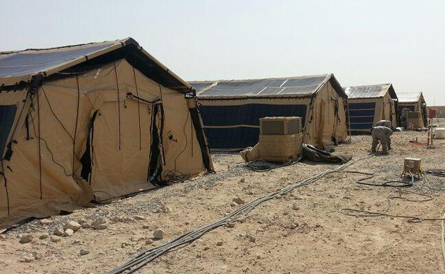Today we will continue our discussion of the tactical Micro-Grid. Last week we discussed energy storage in a tactical Micro-grid, this week we will discuss the use of solar in this arrangement. Solar is quickly becoming an asset in the field to provide a cheap supply of energy. If you size your solar array and energy storage correctly you can utilize the stored energy long into the evening hours. Depending on the location and time of the year, a substantial amount of solar energy is available to be stored and used to run a wide variety of electronics.
Solar arrays can usually be seen either in the form of flexible solar that is designed into a fly over a shelter, or as hard panels placed in the field or on top of a Hard-walled container. One benefit of the fly approach is that it helps to reduce solar load on the shelter and reduces the amount time an air conditioning unit must run to help cool a shelter. The fly approach also allows for a zero footprint set up as you are already using a shelter. This zero foot print set up can also be achieved with hard panels placed on top of a Hard Walled shelter, but must be placed in the field when soft-walled shelters are being utilized.
Each type of solar panel offers pros and cons when being used in the field and, depending on the need, either could be used. Traditionally, people know what a hard panel looks likes and they can target those to be either stolen or destroyed, so additional security is usually required when hard panels are in place. Hard panels are also not able to withstand the same amount of damage of a soft panel. If a hard panel sustains damage from a bullet or shrapnel the whole panel may be destroyed whereas the soft panel will only lose the damaged cells. The biggest drawback of using soft panels is they don’t produce as much energy as a hard panel offers, soft panels are traditionally less efficient then their hard panel counterpart.
When using solar it is important to have other power sources available or extended energy storage to help for days with low sun and evening hours. But once you correctly size your solar array you can see significant reduction in the amount of generator run time and fuel consumption let alone the opportunity to eliminate the generator.

